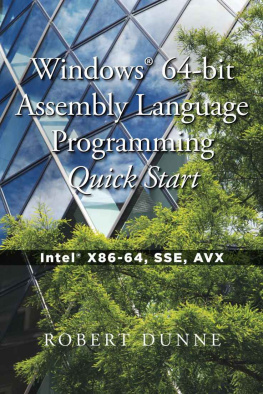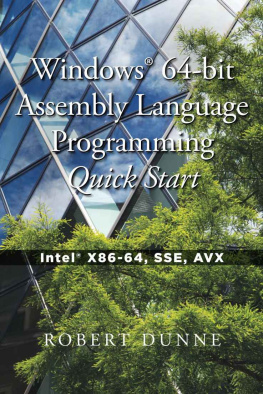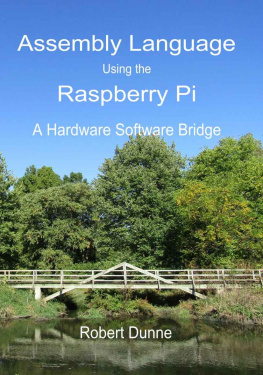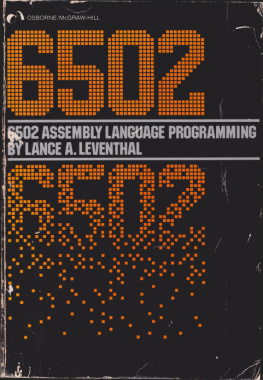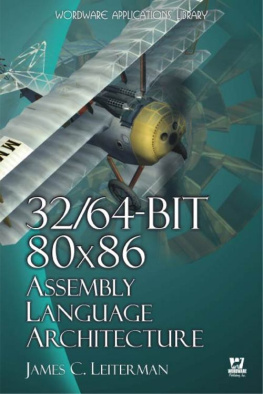Robert Dunne - 64-bit Assembly Language Programming Quick Start
Here you can read online Robert Dunne - 64-bit Assembly Language Programming Quick Start full text of the book (entire story) in english for free. Download pdf and epub, get meaning, cover and reviews about this ebook. year: 2018, publisher: Gaul Communications, genre: Computer. Description of the work, (preface) as well as reviews are available. Best literature library LitArk.com created for fans of good reading and offers a wide selection of genres:
Romance novel
Science fiction
Adventure
Detective
Science
History
Home and family
Prose
Art
Politics
Computer
Non-fiction
Religion
Business
Children
Humor
Choose a favorite category and find really read worthwhile books. Enjoy immersion in the world of imagination, feel the emotions of the characters or learn something new for yourself, make an fascinating discovery.
- Book:64-bit Assembly Language Programming Quick Start
- Author:
- Publisher:Gaul Communications
- Genre:
- Year:2018
- Rating:5 / 5
- Favourites:Add to favourites
- Your mark:
- 100
- 1
- 2
- 3
- 4
- 5
64-bit Assembly Language Programming Quick Start: summary, description and annotation
We offer to read an annotation, description, summary or preface (depends on what the author of the book "64-bit Assembly Language Programming Quick Start" wrote himself). If you haven't found the necessary information about the book — write in the comments, we will try to find it.
64-bit Assembly Language Programming Quick Start — read online for free the complete book (whole text) full work
Below is the text of the book, divided by pages. System saving the place of the last page read, allows you to conveniently read the book "64-bit Assembly Language Programming Quick Start" online for free, without having to search again every time where you left off. Put a bookmark, and you can go to the page where you finished reading at any time.
Font size:
Interval:
Bookmark:

Windows 64-bit Assembly Language Programming Quick Start: Intel X86-64, SSE, AVX
Copyright 2018 by Robert Dunne.
All rights reserved. No part of this book may be reproduced or transmitted in any form or by any means without the prior written permission of the copyright owner and publisher. Published in the United States of America by Gaul Communications, Downers Grove, Illinois.
Cover Design: Daniel van Loon
ISBN 978-0-970112460 (paperback)
ISBN 978-0-970112453 (digital)
Windows 64-bit Assembly Language Programming Quick Start: Intel X86-64, SSE, AVX is an independent publication and has not been authorized, sponsored, or endorsed by any of the hardware or software rights holders described herein.
The publisher makes no warranty, express or implied, with respect to the material contained herein. The program listings, examples, and other information presented in this book are distributed on an as is basis, without warranty. Although every precaution has been taken in the preparation of this book, neither the author nor Gaul Communications shall have any liability regarding its use.
18 17 16 15 14 13 12 11 10 9 8 7 6 5 4 3 2 1
Windows 64-bit
Assembly Language
Programming
Quick Start
Intel X86-64, SSE, AVX
Robert Dunne
I ts time to Take the bull by the horns urged my department head as I was stuck in design mode and not moving fast enough into coding. Fortunately, he was referring to a supercomputer interface project I was developing, and not the herd of bison sharing the national laboratory at which we were on staff. Likewise, the purpose of this book is to get students programming in assembly language as quickly as possible without getting too hung up on adjacent topics.
This book is about programming the Intel X86-64 in assembly language using Microsoft Visual Studio 17 software. The X86 implies the 16-bit legacy Intel 8086 processor up through the 64-bit Intel core i9 and comparable processors from AMD. This is not a book that has been modified or migrates from a 32-bit or 16-bit perspective, but starts right in with 64-bit programming and only refers to past approaches when necessary to explain seemingly unnatural conventions and names.
- All programming examples use the ML64.exe assembler included with the free Community Edition of Microsoft Visual Studio 17, which is used to develop C and C++ programs running in full 64-bit mode.
- Every sample program is complete, but leaves room for enhancements and experimentation encouraged by the questions at the end of each chapter.
- The sample programs, ranging from five to over one hundred lines of code, are extensively documented in both flow diagrams and comments. All are available for download through GitHub.
- Many assembly language books present CPU instructions in catalog form along with snippets of coding examples. In this book, CPU instructions are introduced as needed to achieve programming goals as the projects in each chapter progress to the next.
- Over seventy illustrations are included to explain programming techniques as well as X86, SSE, and AVX instructions.
- Topics like binary and hexadecimal are introduced through programming examples as well as appearing in appendices.
- The examples in this book have been classroom tested with students having very little, if any, previous programming experience. The information is complete, allowing it to be used as an independent study.
The goal of this book is to assist students and computer enthusiasts get on a solid path to understanding computer architecture and also get a deeper understanding of Microsoft Windows programming. The intended audience is the following:
- Anyone wanting to learn assembly language, especially individuals interested in Intel processors and Microsoft Windows.
- Someone who already has assembly language experience, but now wants to become familiar with 64-bit programming.
Expected prerequisites for someone reading this book to learn assembly language:
- Access to an Intel X86-64 based computer running Microsoft Windows 7 or 10. This is the norm for desktop and laptop computers sold in the last decade.
- Enough user computer experience to be able to search for files, use a simple editor such as Notepad, and create a directory.
- Internet access to download the free Community Edition of Microsoft Visual Studio if necessary. Many years ago, Microsoft sold its MASM assembler as a separate product, but now its assembler is only available as part of the C++ component of Microsoft Visual Studio. Many students using this book will have access to computers already loaded with a professional or educational version of Microsoft Visual Studio. For those who dont, the Community Edition is available as a free download from Microsoft, and only the C++ language component is needed.
There are many assemblers available today, and most are available as a free download. Why study the ML64 assembler in Visual Studio 17 instead of others?
- ML64 works both in a traditional Command Line Interface approach and in an Integrated Development Environment (IDE), including its editor and powerful interactive debugger.
- Assembly Language programming in 64-bit mode is much easier than in 16-bit mode or in 32-bit mode. The horrific memory management techniques using segment registers to squeeze applications into small memory spaces are no longer needed. The variety and inconsistency of subroutine calling conventions of 32-bit applications have been simplified in 64-bit Windows.
- Microsoft Windows 10 will not run 16-bit applications. Even 32-bit applications cannot run directly, but must be partially run in an emulation mode. Some day they may be eliminated as well.
- The ML64 assembler is free and down-loadable from Microsoft.
How can a 200 page book be a quick start? Basically, you only have to go as far as you want. Either Chapter 2 or Chapter 13 is enough to get a person programming and running 64-bit assembly language programs using Microsoft Visual Studio.
- The first chapter introduces the concept and structure of CPU machine code in general using examples modeled as a calculator. Those already familiar with CPU architectures in general can easily skip this chapter.
- Chapter 2 provides a command line work flow for developing all of the test programs in the remainder of this book. It includes directions on locating the ML64 assembler, linker, and library, as well as setting up working directories for writing test programs.
- Chapter 3 introduces Windows function calls with a program that reads from the keyboard and writes to the monitor. This read/write console program is then gradually enhanced in Chapters 4 and 5 with additional assembly language instructions and programming techniques using macros, subroutines, and nested loops.
- Chapter 6 focuses on the linker and divides the console application into multiple source files, object files, and a link library.
- In Chapters 7 and 8, more subroutines are added to the console program to produce ASCII, binary, decimal, and hexadecimal outputs showcasing several more instructions.
- Chapter 9 begins a new console program focusing on memory addressing schemes and string instructions.
Font size:
Interval:
Bookmark:
Similar books «64-bit Assembly Language Programming Quick Start»
Look at similar books to 64-bit Assembly Language Programming Quick Start. We have selected literature similar in name and meaning in the hope of providing readers with more options to find new, interesting, not yet read works.
Discussion, reviews of the book 64-bit Assembly Language Programming Quick Start and just readers' own opinions. Leave your comments, write what you think about the work, its meaning or the main characters. Specify what exactly you liked and what you didn't like, and why you think so.

